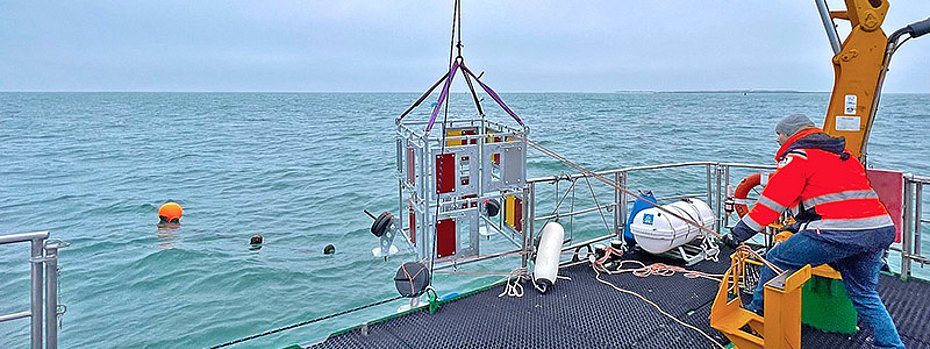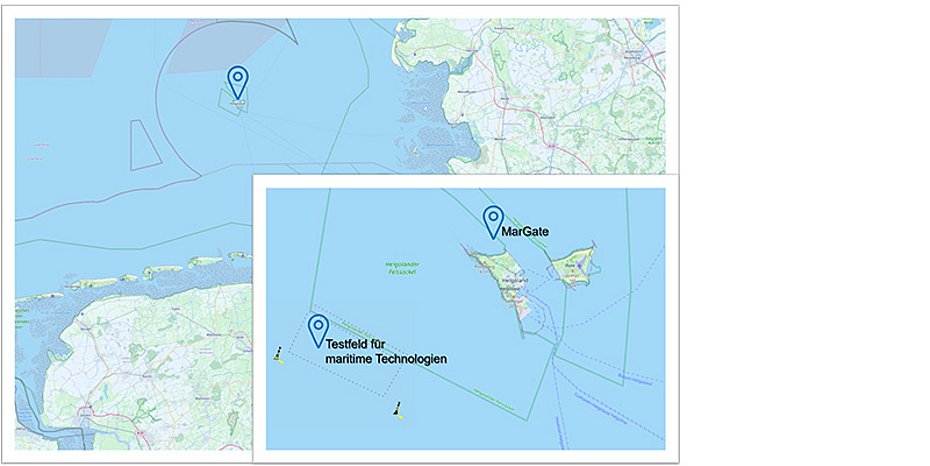In offshore foundations, the settlement of organisms is enormously high. This leads to altered flow conditions, increased loads and complicates inspection tasks. In order to realistically test the development of anti-fouling coatings for this application, a test infrastructure was anchored on the seabed in a specially marked research area off the deep-sea island of Helgoland within the "ROBUST" project. Material and coating samples for the maritime industry can be tested and further developed on the cube-shaped, metallic underwater lander. A research network of regional partners provides this unique testing opportunity.
Rough application environment for coatings
When the wind whips up the sea and a salty spray blows over the waves, it becomes abundantly clear just how harsh this application environment is. This extreme environment imposes numerous requirements on materials and technology that must be met in order to survive in the long term. For the maritime industry, shipping and for use in coastal and offshore areas, the development of robust materials for sustainable use is essential. Also for the development of future technologies, such as floating solar farms or tidal and wave power plants, coatings are of central value for protecting materials and maintaining technical functionality.
Offshore inspection and test infrastructure to be expanded to include subsea lander
Laboratory tests alone cannot fully represent the highly demanding offshore application environment. Application-oriented field tests are therefore an indispensable component for qualifying the newly developed materials and coatings. For this reason, Fraunhofer IFAM has maintained a maritime test center on the deep-sea island of Helgoland for several years. Here, the institute's scientists test and develop various application profiles for the maritime industry. For research and development, there is an outrigger for corrosion and materials testing connected to the harbor pier, an outdoor area for atmospheric weathering, a test stand for static biofouling tests, and the offshore test field for maritime technologies located off the island.
In addition, the "MarGate" underwater test site was established in 2009 by the AWI Center for Scientific Diving on Helgoland to provide an easily accessible marine underwater test area. The area is approximately 270 x 100 meters, has between five and ten meters of water depth, and is marked by six red surface buoys as a maritime exclusive zone for shipping traffic. With the support of the Helgoland and Cuxhaven staff of the Elbe-North Sea Waterways and Shipping Authority, the crew of the workboat "Lumme", the multi-purpose vessel "Neuwerk" and the research divers of the Alfred Wegener Institute, Helmholtz Centre for Polar and Marine Research (AWI), employees of Fraunhofer IFAM have now set down a cube-shaped lander weighing around 300 kilograms made of hot-dip galvanized steel on the rocky bottom of the North Sea at a depth of nine meters.
The newly developed lander enables simultaneous testing of up to 64 coating and material samples measuring 20 x 40 centimeters. The suspended support frames, secured by a bolt, bring a high degree of flexibility. They allow installation and de-installation by divers directly on the seabed and, if necessary, can be adapted to customer-specific geometries with custom-made adapter solutions. The "MarGate" underwater test site also has its own sensor data acquisition system so that important test-related environmental parameters such as temperature, salinity and current conditions can be incorporated into a holistic evaluation of the samples.
The lander expands the existing maritime test infrastructure of Fraunhofer IFAM on Helgoland and will contribute important findings to industry-related research and development work in the future. The near-surface test environment brings with it a different profile of requirements than the near-surface tests which are frequently carried out. The practical relevance of the results for, for example, the design of pipelines, transformer platforms and offshore foundation structures is thus significantly higher. Thanks to the good accessibility of the test field, regular inspection by AWI research divers is also possible.
Deployment of another lander at greater depth planned
In the three square kilometer research test field operated by Fraunhofer IFAM, another lander will be deployed in the summer of 2023. The test field is also only a few nautical miles from the island of Helgoland. The special feature: It has a water depth of 45 meters, so that completely different conditions prevail compared to the "MarGate" underwater test field. The vegetation will be different without sunlight and the water parameters will also be different. Thus, different questions can be addressed in the research areas off Helgoland in the near future. (OM-06/23)
Project Funding
The project "ROBUST" (FKZ: 03SX490) was funded by the Ministry of Economics and Climate Protection of the Federal Republic of Germany (BMWK) based on a resolution of the German Bundestag. The project consortium would also like to thank the staff of the Project Management Jülich (PtJ) for their excellent administrative and technical support of the project.
Project partners
- Fraunhofer IFAM,
- Dr. Brill & Partner GmbH,
- Momentive Performance Materials GmbH
Duration: 01.11.2019 - 30.04.2023
Contact
Fraunhofer Institute for Manufacturing Technology and Applied Materials Research IFAM
Wiener Straße 12
28359 Bremen (Germany)
Phone +49 421 2246-0
Email: info@ifam.fraunhofer.de
www.ifam.fraunhofer.de
About Fraunhofer IFAM
Founded in 1968 and integrated into the Fraunhofer-Gesellschaft in 1974, Fraunhofer IFAM is one of Europe's most important independent research institutes in the fields of adhesive bonding technology, surfaces, shaping, and functional materials. The focus is on research and development work at the five institute locations in Bremen, Dresden, Stade, Wolfsburg, and Braunschweig, as well as on the North Sea island of Helgoland, with the aim of providing reliable and application-oriented solutions.


